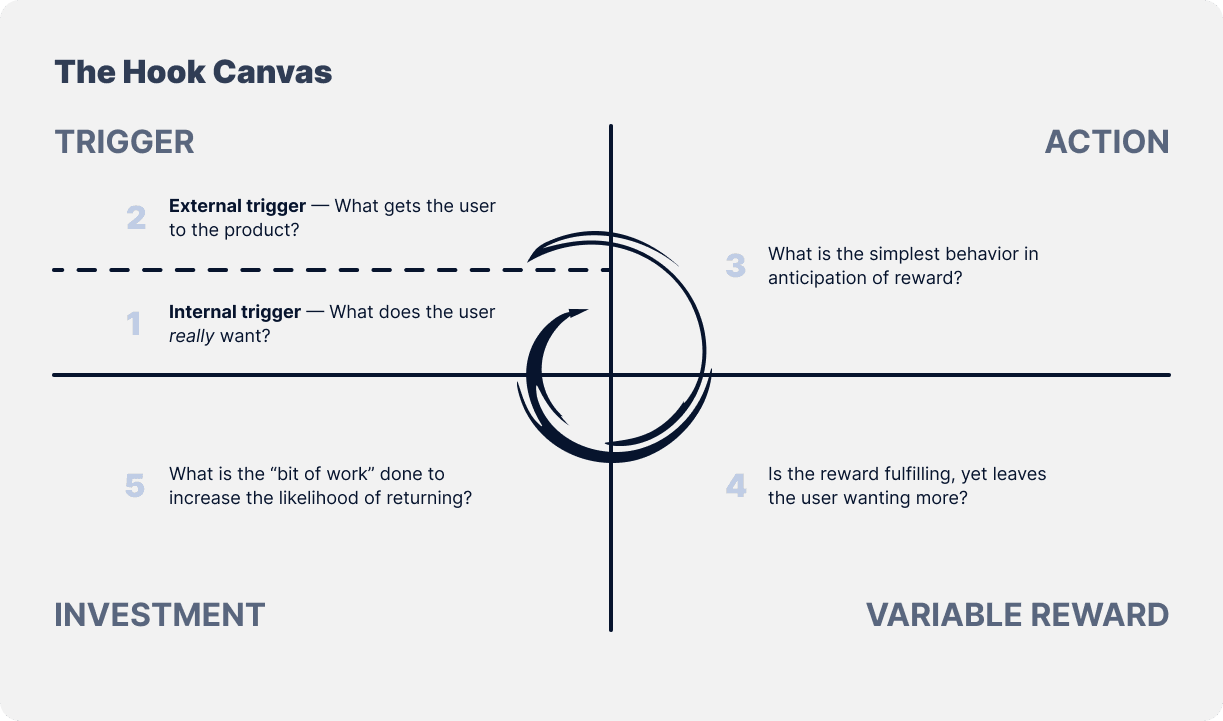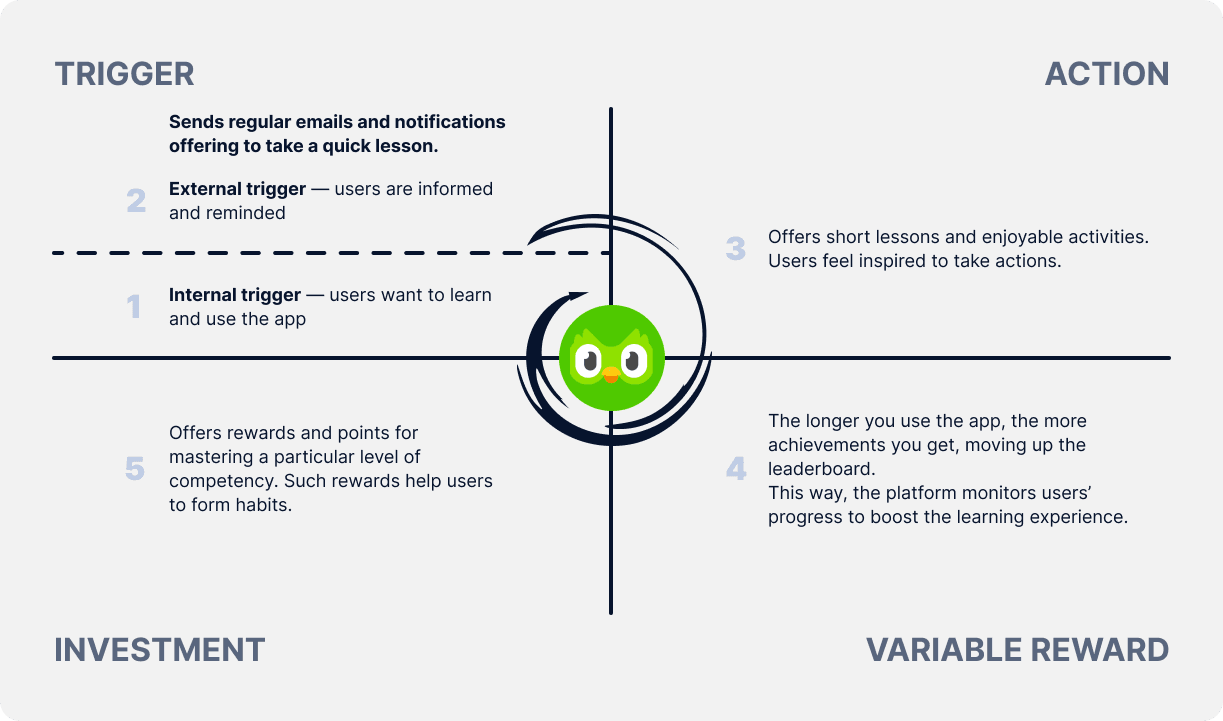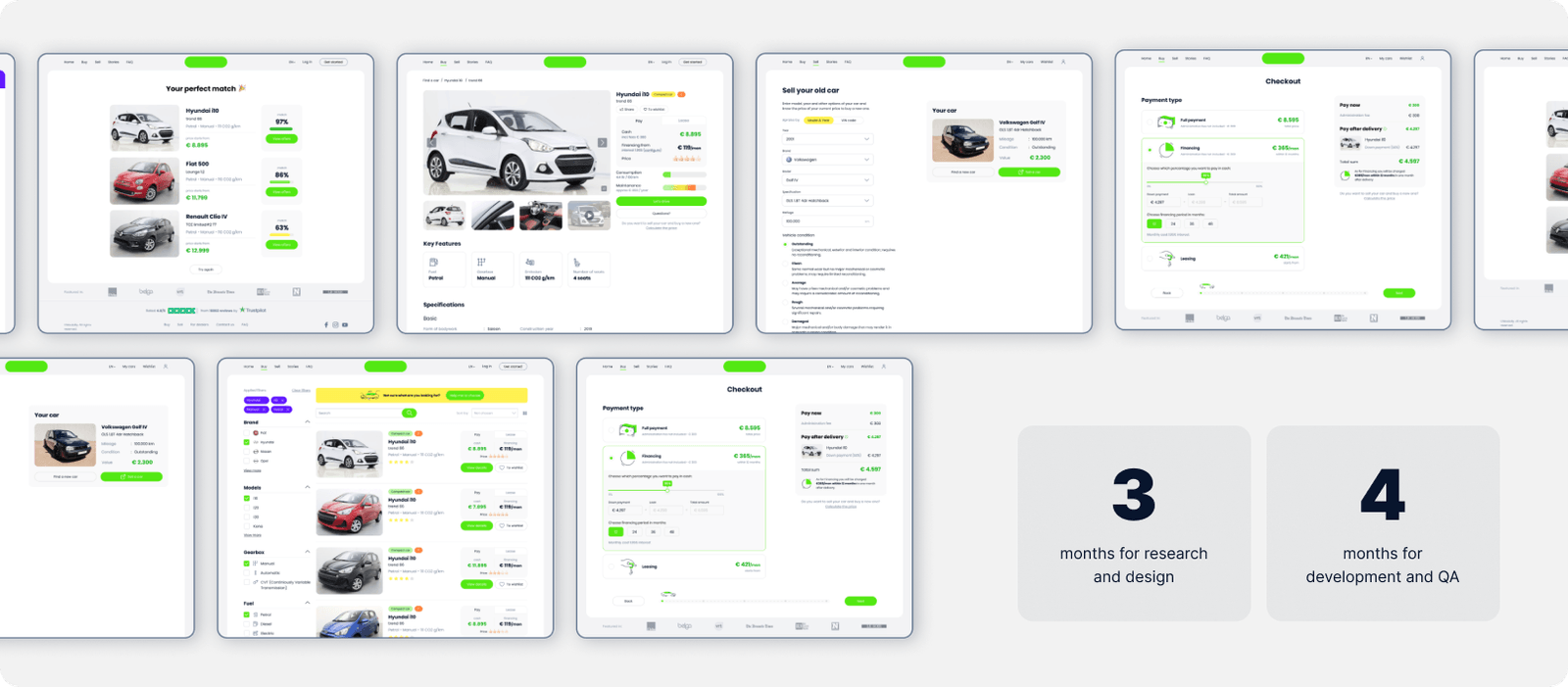
May 25, 2023
The Hooked Model: 4 Must-Follow Steps
In the era of advancing technologies, companies constantly develop new strategies to stay relevant in the minds and lives of their customers. They need to overcome countless distractions competing for people’s attention. Firms realize the more addictive their products are, the more value their businesses will have. Some are only becoming aware of the power of habit-forming products. Others, in turn, are already employing Nir Eyal’s "Hooked Model" to win their clients' loyalty and reduce long-term marketing expenses.
This article will review the Nir Eyal Hooked Model’s importance, core components, and use cases. Also, we will demonstrate how we use this framework by sharing the expertise of Artkai in product design. Finally, you will learn how we build winning design solutions to expand our clients’ user base and revenue streams, leading products to success. Ready? Then, let’s dive deeper into the details!
What Is the Hooked Model?
The Hooked Model is a four-step approach businesses use to create goods or services that consumers use habitually. This concept was developed by an American-Israeli behavioral economist Nir Eyal. The Hooked Model aims at connecting a customer's problem to a company's solution with sufficient frequency to turn engagement into an ongoing practice.
The Hooked Nir Eyal Model describes how a user interacts with a product as they move through four phases:
- A trigger to start using the product;
- An action to satisfy the trigger;
- A variable reward for the action;
- An investment to increase the product's value to a user.
Users develop habits while going through these four phases. When this process occurs frequently enough, clients continue using a product whenever they face a problem. That’s because they perceive it as an obvious solution.
Why Is the Hook Model Important?
The Hook Model helps brands stand out in the busy market, get customers' attention, and, most importantly, hold it. It defines the process of creating products that consumers will adapt to. Now, it’s time to take a closer look at the benefits of adopting the Hook Model. Here’s what it can deliver for your business.
- Explaining what influences consumer behavior.
- Ensuring that new products or services become habit-forming for customers.
- Giving businesses a significant competitive advantage.
- Encouraging engagement and loyalty with your brand.
- Eliminating the need for pushy messages and hard sell.
- Lowering long-term marketing expenses.
The more times a consumer goes through the Hooked Eyal Model cycle, the stronger their attachment to your product is. Moreover, they will be more likely to self-trigger using your product again.
The Hooked Model Components
Сonsumers develop habits as they move through the four critical stages of the Hooked Model's cycle:
- Trigger
- Action
- Variable Reward
- Investment

Let’s explore each phase in more detail.
Trigger
The ignition mechanism in the Hooked Model is the trigger. It’s the actuator of customers’ behavior. The triggers come in two categories: internal and external. Technologies helping users build habits first alert consumers with external triggers (emails, website links, or phone app icons).
By cycling through these product hooks, users develop associations with internal triggers linked to pre-existing behaviors and emotions. They quickly become internally activated if they experience a particular emotion. The habit establishes when the internal trigger incorporates into a regular activity.
Let’s take the language learning platform Duolingo as one of the hook strategy examples. After downloading the app and starting to learn, you receive regular emails and notifications encouraging you to take a quick lesson. Thus, once the external trigger occurs, the internal trigger — the desire to learn a new language — comes into play.
Action
The intended action follows the trigger. In this step, companies appeal to pulling mechanisms of human behavior like motivation and ability. A behavior designer makes the activity as straightforward as possible while increasing the users’ motivation. Thus, customers are more likely to take the desired action. In this stage of the product hook, usability design ensures that a user behaves as intended.
Now, let’s get back to the Duolingo case. The lessons in the app are short, and the activities are enjoyable. As a result, you feel your progress and improvement as you complete each unit, which inspires you to keep going.
Variable Reward
The capacity of hooks to incite desire in the user distinguishes them from a simple feedback loop. Although they are all around us, predictable feedback loops do not awaken desire. You don't have to repeat a specific action if you know what happens when you do it. But if you throw in some variation, curiosity occurs.
A variable rewards schedule is one of the most effective ways to hook customers. When a person anticipates a reward, dopamine levels rise. Variability increases the impact, causing a “hunting” mood and activating brain areas related to seeking and desire. Some classic examples of this approach are lotteries and slot machines. However, habit-forming technologies also tend to adopt variable rewards.
As one of the hook model examples, Duolingo offers a variable reward for mastering a particular level of competency. In the app, you make numerous achievements when reaching a streak. Also, you earn XP points, learn new words, advance to a successive league, and complete lessons without mistakes. Such rewards are pretty effective at forming habits.
Investment
Users should put in some effort at the final hook framework stage. The desired behavior for this phase is twofold. The first is to make customers more likely to use the Hook again when the next trigger appears. It's time to pay some bills now since users expect the reward in the previous step. In most cases, they need to invest some time, data, effort, social capital, or money.
Unlike a sales funnel with a predetermined ending, the investment phase doesn’t require customers to pull out their wallets and go on. Instead, it suggests a move to enhance the service for the upcoming transaction. Every user's commitment (inviting friends, expressing preferences, creating virtual assets, and learning to use new features) leads to improvements.
With each run through the Hook, these investments can make the trigger more exciting, the action more straightforward, and the reward more appealing. For instance, in Duolingo, the longer you use the app and complete the lessons, the more achievements you get, moving up the leaderboard. Furthermore, users of Duolingo can challenge friends. This way, the platform monitors users’ progress to boost the learning experience.

When Is the Hook Model Used?
The hook method suggests that habit-forming products are more competitive as customers keep returning to them without expensive advertising and hard selling. Let’s look at particular cases when this model is beneficial.
Product Discovery
In SaaS, the Hooked Model provides product teams with the resources to create solutions and services aiming at high user engagement rates. Such a company can take advantage of this model at any point while developing a product. Besides, the Hooked model Nir Eyal is an effective tool from the product management standpoint. A product development roadmap will help oversee the discovery stage and convey your initial goals and plans.
Determining and Meeting User Needs
The model assists you in identifying user needs and the most effective ways to meet them. In particular, a marketing team can use it to determine the best strategies for luring new clients. Meanwhile, development teams employ it to create product specs and prototypes. Note that you can make the most out of this model by tracking the right product development KPIs.
Artkai Expertise
Artkai is a customer-centric digital product development agency. We implement the Hooked model to create outstanding design solutions. Our experts ensure improved usability, better user satisfaction, and increased conversion thanks to our efficient product design approaches. We always aim to increase clients' user base and revenue sources, guiding products to success.
Artkai can assist you in incorporating result-driven product design research and profound market insights into your product design. Our practical solutions, with core features and user-friendly interfaces, will captivate new clients and rule the digital market.
We adhere to a simple and intuitive workflow when creating applications.
- Research and conceptualization. Market research is the initial stage in delivering your product design. It aids in comprehending current market trends, consumer preferences, and general dynamics. The main objective here is to make a product that offers a compelling combination of characteristics.
- Wireframing. We translate the insights gained from the market analysis into concise and visually appealing wireframes. This stage involves idea visualization and breakdown to make sure the proposed features correspond to the market requirements.
- Validation and testing. When wireframes are ready, we collect feedback from users on the suggested design alternative. We show wireframes to target consumers. This way, we determine if the audience finds our design appealing or needs specific improvements.
- Visual design. We now have sufficient information to design more intricate, polished interfaces for your product. At this stage, you are one step closer to understanding its final appearance and UI elements.
- Product development. Now, we can finally turn a design solution into a usable product with a wide range of functions and a user-friendly, interactive interface. You get a functional design that sells well and converts users into loyal customers.
Let’s review what our process looks like in practice.
DNA Payments: An Intelligent Payment Ecosystem
DNA Payments Group, a provider of omnichannel payments for the EU and the UK, requested the Artkai team to update their existing portal. Our experts started working on this project with the following steps:
- desk research
- interviews with the stakeholders
- audit of the current product
- customer personas
- customer journey map
We redesigned significant parts of the portal and created an intelligent payment ecosystem.
Our joint efforts led to notable results. DNA Payments became the fourth-largest payment service in the UK by the end of 2022, providing services to over 65,000 merchants. The site currently processes £900,000,000 per month for corporate clients and offers a complete range of payment options.

Marketplace for New and Used Cars
The client requested our team to create a brand-new online marketplace for buying and selling European cars. Our professionals provided the following services:
- Marketplace development
- User experience design that reduced the time to buy a car by addressing customer pain points
- Visual identity for the online product
After the launch, the marketplace swiftly gained merchants and buyers. Our client managed to cooperate with major car vendors so that we could fill the platform with intriguing deals. We were pleased to see that the customers spent significant time in the marketplace. This indicator supported our UX choices. As a result, the client received 1 million monthly payments through the platform and over 80 car dealers in Europe.

Streamline Your Product Design with Artkai
A successful company should provide value to clients and acquire lucrative new customers before monetizing and expanding. You should find out where further technological advancement makes cycling through the Hook Model quicker, easier, or more enjoyable. It creates an ideal environment for creating new habit-forming products. An experienced vendor will help you design the product to gain customers’ loyalty by transforming their behavior.
Artkai is an award-winning full-cycle product development company with rich expertise in product design services. Artkai professionals integrate extensive market knowledge and decades of product design study into your product development. We follow the best practices and consistent workflows to build winning design solutions that attract new customers and dominate markets.
Contact us to discuss your product idea and get an estimate.
Clients and Results
Schedule your free consultation
Don't miss this opportunity to explore the best path for your product. We are ready to delve into the specifics of your project, providing you with expert insights and optimal solutions.
Book your free sessionRead More
Explore articles from Artkai - we have lots of stories to tell
Join us to do the best work of your life
Together we advance the human experience through design.